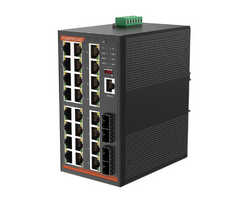Ethernet is the most popular way to connect devices in an industrial setting. It’s fast, it’s reliable, and it’s easy to use. But as Ethernet speeds have increased, so too has the need for more reliable and higher-performing Ethernet switches. That’s where gigabit industrial Ethernet switches come in. These switches are designed for mission-critical applications that require high bandwidth and low latency. In this blog post, we’ll explore some of the reasons why you might need a gigabit industrial Ethernet switch for your next project.
The Basics of Ethernet Switching
The Ethernet switch is the basic building block of any Ethernet network. It is a device that connects multiple devices together on an Ethernet network, allowing them to communicate with each other.
Ethernet switches come in all shapes and sizes, from small desktop units to large chassis-based switches. But they all perform the same basic function: they receive data from one or more devices, process it, and then send it out to another device or devices.
Switches are classified by the number of ports they have. A port is a connection point on the switch where a device can be connected. The most common types of switches are 8-port and 16-port switches. Larger switches can have 24, 48, or even 96 ports.
Ethernet switches can be either managed or unmanaged. Managed switches give you more control over your network because you can configure them using special software. Unmanaged switches are easier to set up but offer less control.
Gigabit Ethernet (GbE) is the latest standard for Ethernet networking. It offers speeds of up to 1000Mbps—ten times faster than the previous generation of Ethernet (100Mbps). GbE is becoming increasingly popular as more and more devices support it.
When choosing an Ethernet switch for your network, there are several factors to consider: port count, speed (10/100/1000), management capabilities, and price. 10/100/1000 refers to the speed of each port Guest Blog Posting Services UK
Advantages of a Gigabit Ethernet Switch
An Industrial gigabit Ethernet switch is a device that helps connect multiple devices on a network to share data and resources. Here are some advantages of using a gigabit Ethernet switch:
-Higher Speed: A gigabit Ethernet switch can provide up to 10 times the speed of a Fast Ethernet switch, making it ideal for high bandwidth applications such as HD video streaming or large file transfers.
-Greater Distance: A gigabit Ethernet switch can Guest posting sites extend the reach of your network by up to 550 meters (compared to 100 meters for Fast Ethernet). This can be useful if you need to connect devices that are far apart from each other.
-Better Reliability: A gigabit Ethernet switch is designed for mission-critical applications and can offer greater reliability than a Fast Ethernet switch.
Industrial Ethernet Switches
Industrial Ethernet switches are designed to withstand the rigors of industrial environments. They are built to provide reliable network connectivity in harsh conditions, such as extreme temperatures and vibration. Industrial Ethernet switches also offer advanced features, such as PoE support and redundancy, that make them ideal for mission-critical applications.
Managed vs. Unmanaged Ethernet Switches
If you manage your own Ethernet network, you need to understand the difference between managed and unmanaged switches. Unmanaged switches are easier to set up and require no configuration. Managed switches, on the other hand, offer more features and control over your network.
Both types of switches have their pros and cons, so it’s important to understand the difference before making a decision. Here’s a rundown of the key differences between managed and unmanaged Ethernet switches:
Managed Switches:
– More expensive than unmanaged switches
– Require configuration and management
– Offer more features and control over your network
– Ideal for larger networks or those with special requirements
Unmanaged Switches:
– Cheaper than managed switches
– No configuration or management required
– Limited features and control over your network
– Ideal for small networks or those with simple requirements
When to Use an Industrial Ethernet Switch
Industrial Ethernet switches are designed to provide a rugged, reliable connection in harsh environments. When selecting an industrial Ethernet switch, it is important to consider the specific needs of your application.
If you need to connect devices in a factory or other industrial setting, an industrial Ethernet switch is likely the best option. These switches are designed to withstand vibration, dust, and extreme temperatures. They also offer features like port forwarding and Quality of Service (QoS), which can be important in industrial applications.
Conclusion
There are many reasons to consider a gigabit industrial Ethernet switch for your business. The increased speed and performance can help improve efficiency and productivity, while the reduced costs can help improve your bottom line. If you’re looking for an Ethernet switch that can offer these benefits and more, a gigabit industrial Ethernet switch is worth considering.



